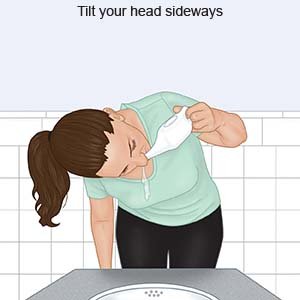Nasal Rinse
Medically reviewed by Drugs.com. Last updated on Aug 4, 2025.
What is a nasal rinse?
A nasal rinse is the use of a salt water solution to thin mucus, and clear irritants and allergens from your nose. Irritants and allergens cause symptoms such as congestion, runny nose, or postnasal drip. A nasal rinse can also help to remove bacteria and viruses that cause infections. It may also be recommended after certain nasal surgeries to promote healing.
What supplies do I need?
You can purchase a nasal rinse kit at a pharmacy. A nasal rinse kit provides all the supplies you need. You can also make salt water solution at home. A bulb syringe, sinus rinse bottle, nasal cup, or neti pot can be used to put the salt water into your nose. A sinus irrigator device can also be used to put the salt water into your nose. Ask your healthcare provider which method is best for you.
Related medications
How do I make the salt water solution at home?
Wash your hands with soap and water before you begin. Do the following to make the salt water solution at home:
- Mix ½ teaspoon of uniodized salt with 8 ounces of lukewarm water. Use only distilled water, sterile water, or filtered water. Water should be filtered through a filter with a pore size of 1 micron or smaller. You can also use water that has been boiled for 1 minute and left to cool. If you live at an elevation over 6,500 feet, boil the water for 3 minutes.
- Add ¼ teaspoon of baking soda to the solution and mix until it completely dissolves.
- Make a new mixture of salt water solution each time you do a nasal rinse.
How do I do a nasal rinse?
Ask your healthcare provider how often you should do a nasal rinse. You may need to do a rinse 1 or 2 times each day.
- If you have a nasal rinse kit, follow the directions in the package.
- If you made your own salt water solution, put the solution into the nasal cup, neti pot, or nasal rinse bottle. To fill the bulb syringe, squeeze the bulb syringe gently in the solution and let it fill by suction. If you are using a sinus irrigator device, pour the salt water into the water reservoir.
- Lean over the sink with your head facing down. Tilt your head sideways.
- To use a bulb syringe or rinse bottle , insert the tip into your upper nostril. Aim the tip away from the middle of your nose. Breathe through your mouth. Squeeze the syringe or bottle until a gentle stream of salt water goes into your nose and drains out of the lower nostril. Repeat in the other nostril.
- To use a sinus irrigator device , set the device to the lowest pressure setting. Breathe through your mouth. Insert the tip inside your upper nostril. Aim the tip away from the middle of your nose. Allow the fluid to go into your nose and drain out of the lower nostril. Repeat in the other nostril.
- To use a neti pot or nasal cup , place the spout into your upper nostril. Breathe through your mouth. Gently pour the salt water into your upper nostril and allow it to drain into the lower nostril. Repeat in the other nostril.

- You may gently blow your nose to remove any extra fluid.
- Throw away any unused salt water solution. Clean your nasal rinse supplies after each use to prevent the growth of bacteria.
How do I clean my nasal rinse supplies?
- Clean the bulb syringe by filling it with water and swishing the water around. Empty the water. Next, draw rubbing alcohol into the bulb syringe and swish the alcohol around. Empty the bulb syringe. Place the bulb in a clean empty glass with the tip facing down to allow it to drain completely.
- Clean the sinus rinse bottle and its parts with a small amount of dishwashing soap and water. Rinse the bottle and cap with water. If your sinus rinse bottle is microwave safe, fill it with cold water and heat it in the microwave for 2 minutes. Allow the bottle and cap to dry on a clean towel. If the sinus rinse bottle and cap appear discolored, disinfect them. To do this, rinse them with rubbing alcohol or vinegar solution. To make the vinegar solution, mix 1 part vinegar to 3 parts water.
- Clean the neti pot or nasal cup with soap and water. Leave the device open so it can air dry completely.
Care Agreement
You have the right to help plan your care. Learn about your health condition and how it may be treated. Discuss treatment options with your healthcare providers to decide what care you want to receive. You always have the right to refuse treatment. The above information is an educational aid only. It is not intended as medical advice for individual conditions or treatments. Talk to your doctor, nurse or pharmacist before following any medical regimen to see if it is safe and effective for you.© Copyright Merative 2025 Information is for End User's use only and may not be sold, redistributed or otherwise used for commercial purposes.
Further information
Always consult your healthcare provider to ensure the information displayed on this page applies to your personal circumstances.
